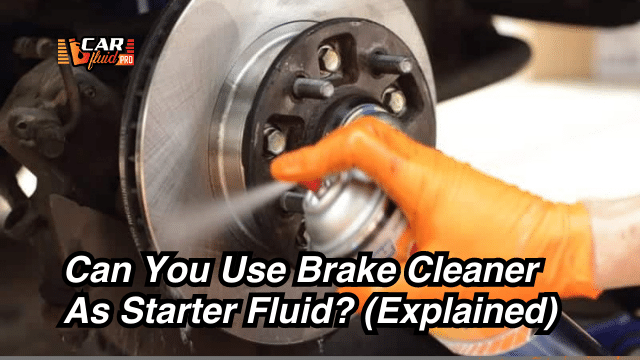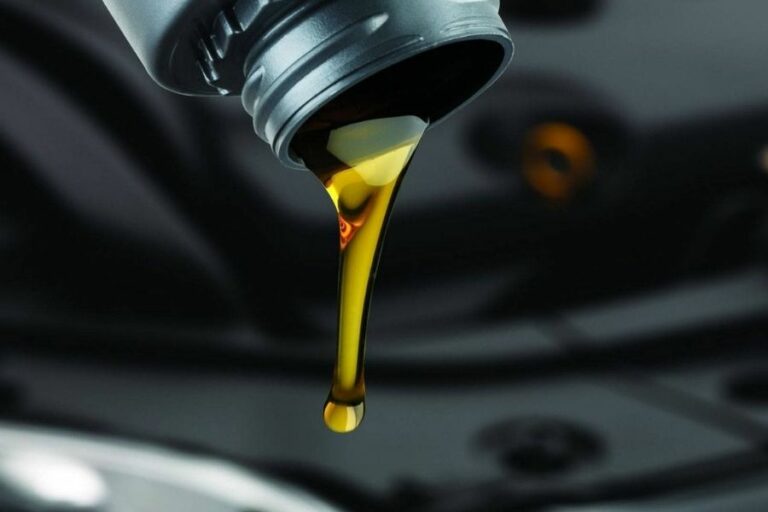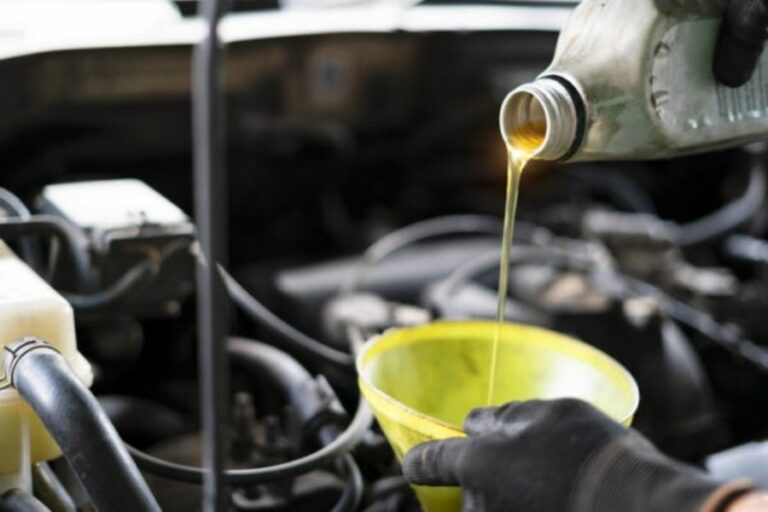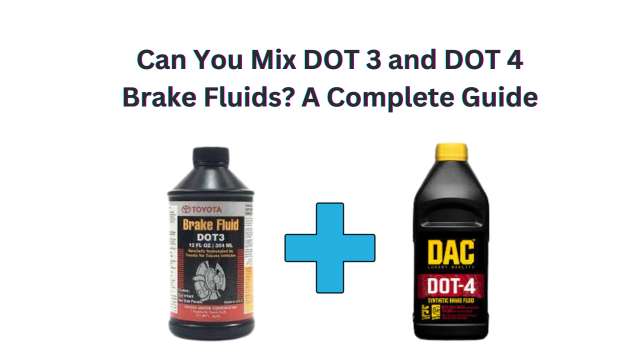Can You Use Brake Cleaner As Starter Fluid? (Explained)
You may feel anxious if you get in your vehicle and can’t start it quickly enough. One method to make this process go quicker is to utilize starter fluid. This extremely flammable and petroleum-based fluid evaporates more rapidly than gasoline, leaving you desperate to find more.
So, can you use brake cleaner as starter fluid? The answer is both yes and no. Yes, it’s debatable. Generally, using brake cleaner as starter fluid is prohibited, but you can use it only when you have nothing left during an emergency.
Still, starting your engine next time might be challenging. In addition, the resulting damage may last permanently. Now, you may have become more confused about what you should do. Don’t worry; we have gathered some useful information below.
Is Brake Cleaner The Same As Starting Fluid?

Before your curiosity creeps into positive thoughts, you should know whether brake cleaner is similar to the starter fluid. The straightforward answer is “No.” Just look at the below; we have pointed out their major differences.
Chemical Composition
The chemical composition of brake cleaner and starter fluid is the major factor that distinguishes these two liquids. Let’s have a look at their chemical compositions:
Brake Cleaner
The chemical composition of brake cleaner can be different depending on the type of brake cleaner. There are two types of brake cleaners, which are Chlorinated and Non-chlorinated.
A chlorinated brake cleaner made from organochlorines, such as dichloromethane and trichloroethylene. It is often called an R-rated dry cleaner because it is prohibited in the United States. It was used as recently as the 1960s, but since it contributes to ground-level ozone depletion, it has been phased out.
Some brake cleaners don’t use chlorinated components, which are known as non-chlorinated brake cleaners. These cleaners often use these hydrocarbons as the main ingredient: it will either be a low-boiling aliphatic liquid or a higher-boiling hydrocarbon mixture.
Aromatic hydrocarbons, such as toluene, benzene, or xylene, are also permitted. Saturated hydrocarbons can be turned into highly-boiling hydrocarbons by hydrogenation from naphtha.
Starter Fluid
In the early stage, small amounts of diethyl ether, with a trace quantity of a hydrocarbon propellant and a stabilizer, have been used as a tiny catalyst to help start motor vehicle engines. This is mainly because the mixture has a lower auto-ignition temperature of about 160 °C (320 °F).
At present, the principal part of natural gasoline is heptane, which is used as a starting fluid in potions. Some contemporary starting fluid products contain a mixture of nearly equal parts heptane and diethyl ether, along with carbon dioxide as a fuel.
The most commonly used products that contain butane or propane have greatly reduced toxicity and are used as both starter fluid and propellant.
Intended Use
The principal application of brake cleaner is centered in your car’s braking system and used as a way to wash oil, dirt, tar, and grease from the brake system. It’s also intended to dampen vibrations fully, eliminate tire squeals, and evaporate promptly without forming residue or spots.
Whilst, the starting fluid has a very different function than the brake cleaner. The main purpose of the starting fluid is to keep the engine in a favorable state to ensure optimal combustion.
Prior to starting the engine, this liquid ensures maximum service life. It does not emit toxic gasses while keeping lubricating parts well, prevents rusting, and makes the vehicle much easier to lift.
Read Also: Car Starts With Starter Fluid Then Dies
Can You Use Brake Cleaner As Starter Fluid?
Diverse additives are used to create starting fluid, such as special detergents. Through these additives, the efficiency of a pump boosts because it can eliminate the internal accumulation of dirt and deposits.
It also explains the theory of using brake cleaner as a substitute for starting fluid. So, you can resort to the brake fluid only in an emergency.
You will find brake cleaners in two distinct containers, one is conventional cans, and another is the aerosol spray can. However, you should always choose the aerosol spray can while using it as a starting fluid.
Why You Should Avoid Using Brake Cleaner As Starting Fluid?
As you can see, we continuously encourage you to avoid substituting starting fluid with brake cleaner. Here are some of the dangerous impacts of brake cleaners that you should be aware of.
Environmental Impact
The solvent of brake cleaners may inflict damage on the human system, depending on the chemical composition.
Brake cleaners can be poisonous when in storage or usage. They may even be harmful to the ozone layer.
Toxicity on Human Body
Chlorinated brake cleaners break down easily being exposed to light or high temperatures, especially when temperatures or light radiation are high.
These compounds will then split into hydrogen chloride and phosgene. The two substances pose a danger to your respiratory and other organs in your body.
Component Damage
Rubber or plastic ingredients are assailed by brake cleaners, destroying them or generating lasting damage.
Brake cleaners destroy plastic components by breaking down the bonds that hold them together. Initially, plastic appears undamaged, but after a while, it will break down and become brittle.
Read Also: Brake Fluid Leaking Under Middle of Car | What to Check?
How to Spray Brake Cleaner to Use As Starter Fluid?
Let’s assume your situation demands using brake cleaner as a replacement for starter fluid. Nevertheless, if you can’t apply the brake fluid properly, it can lead to something even worse than the potential damage. So, follow the steps mentioned below while spraying the brake cleaner:
Quick Preparatory Works
Before spraying the brake cleaner (or using the starter spray), you need to let air into the working area by opening the air valve and making sure the choke is open so that brake cleaner fluid can enter the diaphragm area and the air intake port or intake camshaft sensor’s air filter.
To guarantee it is appropriate for igniting the gas chamber and starting the vehicle, check the composition of the brake cleaner beforehand.
In case your car has a diesel-powered engine, the brake cleaner may not spark as you anticipate, and it can even create blue smoke. You can set up almost any engine vacuum using a handy interval maintained by the interval.
Select a brake fluid that can work at minimal usage. You can actually head to a trusted shop that sells high-quality products to get the best engine degreaser.
Find the Air Intake
Air intakes are situated inside the motor vehicle, where fuel is blended with air needed for combustion. The air intake will always be attached to the engine underneath the hood.
But different manufacturers equip their vehicles with different specifications, causing the intake to be located in a different location on a vehicle from different manufacturers.
You may be able to find the location of your vehicle’s air intake in your user guide. Air intakes occasionally look like metal pipes. They may be clad in powder coat or painted using the same color as the motor vehicle.
Spray the Brake Fluid
Here, a bottle of spray gun will need to be sprayed in the air intake manifold for about 2 seconds when you use it to expel dirt from the air intake manifold. Then, close the airline and carry on launching the engine. If the engine starts smoothly, then you are good to go.
Otherwise, you’ll have to decide to spray the brake cleaner again. You may need to aerate the engine by putting a certain amount of brake cleaner into the throttle body and pushing the engine accelerator.
Cautions:
As you know, brake cleaners can be extremely hazardous for your health and the environment. So, keep the following cautions in mind:
- You should use only a small amount of brake cleaner while spraying on the air intake or the throttle body.
- Compensate your breathing masks, filters, or any other protection you may need for your face while applying brake cleaner, and wear safety glasses. If it hits your eyes, rinse thoroughly with water for several minutes.
- Replicate rubbing your eyes with a moist towel to reduce brake cleaner irritation because of contact. However, if the irritation does not stop after rinsing with water, be sure to see a physician.
- If you’re using brake cleaner in an obstructed area, move to an open, well-ventilated space as soon as possible. Take a shallow breath if the chemical starts making you sick, but be careful not to breathe any deeper if you cannot breathe normally.
- Be ready for some manufacturer-specific warnings regarding the use of each brake cleaner. Be aware when in doubt because you may determine that certain canon of work can lead to dangerous situations.
What Can You Substitute For Starting Fluid?
After learning about so many harmful impacts of brake cleaners, you might be searching for something else you can utilize. Here are some of the starting fluid alternatives:
Ether Solution
The initial liquid to select for use as starter fluid is ether solution. It’s been used for years owing to the fact that it’s the least harmful to the human body compared to other alternatives.
Gasoline and Oil Mixture
You can also use a gasoline and oil mixture as starting fluids. For this, you should have a canister with a spray gun and fill it with the mixture. You can easily manage the ingredients from a two-stroke motorcycle engine or a lawn mower.
However, make sure the area is open and has sufficient airflow. Alongside, use only a small amount of the mixture.
Other Alternatives
Thankfully, there are some other potential alternatives to starting fluid. These include:
- Carburetor cleaner
- Throttle body cleaner
- Degreaser
- Seafoam engine cleaner.
- Mass airflow sensor cleaner
FAQs
Our team has put much effort into mastering this topic, but there may be a few more concerns that you have yet to comprehend. In light of this, this section is intended for those who wish to glean more information.
Can you use wd40 as starting fluid?
Yes, but if you want to start your car’s engine, you may spray WD-40 or a liquid aerosol into your car’s carburetor. WD-40 contains polyoxymethylene acid and naphthenic base oil, and this fuel will start your vehicle but will quickly turn to smoke and flame as the naphthenic acid burns off.
Does brake cleaner damage fuel injectors?
Brake cleaner is a rather toxic chemical and unsuitable for injector use. It might end up causing damage. Injectors are more sensitive than a brake assembly and require a cleaner that neutralizes by-products of gasoline combustion, not dirt from road or ceramic deposits.
Will brake cleaner hurt your engine?
Continuous use of brake cleaner can damage the engine. However, they’re indispensable for cleaning components used with oil. It may be worth the effort to examine the oil gasket and O-ring carefully, as these components could be affected by residue.
How often should I use brake cleaner?
Within proper storage and special conditions, brake fluids can remain workable for up to 6 years. Store such ASAs (aerosols) in cool and dry locations at or below 50 °C, of course, out of direct heat and naked flames.
Final Words
So, it’s time to sign out. Before we leave, ask yourself, can you use brake cleaner as starter fluid? Maybe your inner self will answer, “do it but don’t overdo it.”
Yes, it created a mixed situation, but when it’s extremely cold outside, and your brake cleaner can help you to start the car, why not use it?
However, don’t forget the cautions we have mentioned earlier because your safety should be a prime concern above all.






